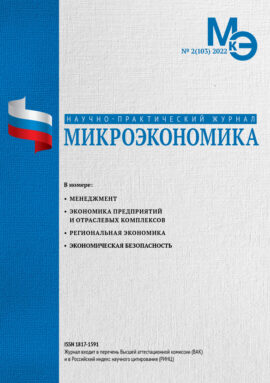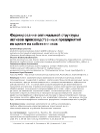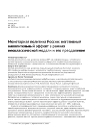Formation of an optimal asset structure of production enterprises according to the goals of their owners
DOI: 10.33917/mic-2.103.2022.58-64
The article considers the issue of forming the optimal structure of assets of manufacturing enterprises according to the goals of their owners. An original approach is proposed to optimize the structure of the company’s assets according to the criterion of maximizing their effectiveness for owners through the enterprise capitalization indicator.
To link the indicators of capitalization and profit from the existing assets of manufacturing enterprises of the manufacturing industry, the authors propose to create a multiple regression model, where the independent variable is capitalization (profit), the dependent ones are indicators of specific assets.
After finding the contributions (regression coefficients) of each asset, we propose to form their structure according to the principle of a portfolio approach, in which the efficiency indicator of all assets will strive to the maximum and at the same time the specific features of the enterprise in each case will be taken into account [10].
References:
1. Azrilinyan A.N. Big Economic Dictionary. M.: Institute of New Economics, 1997. (In Russ.).
2. Bezpalov V.V., Dorofeev A.Yu., Gorin D.S., Marien L.S. Designing stages of anti-crisis organizational engineering of agricultural enterprises within the universal management cycle. Journal of Applied Research. 2021;1(4):22-35. (In Russ.).
3. Blazhevich O.G. Turnover indicators and their significance for assessing the efficiency of asset use // Scientific Bulletin: Finance, Banks, Investments. 2018;4 (45):31-38. (In Russ.).
4. Brigham Yu., Erhardt M. Financial management: St. Petersburg: Peter, 2009. (In Russ.).
5. Voloshchuk L.A., Tkachev S.I., Monina O.Yu. Statistics. Educational and practical manual: Saratov, 2016. (In Russ.).
6. Van Horn D., Vakhovich D. Fundamentals of Financial Management: M.: Dialectics, 2020. (In Russ.).
7. Dorofeev A.Yu., Filatov V.V., Medvedev V.M., Shestov A.V., Fadeev A.S. Methodology for calculating the discount rate using the capital asset valuation model. Online journal of Science Studies. 2015;7(2 (27)):18. (In Russ.).
8. Mukhidov R.H., Simonova V.A., Filatov V.V. Initial public offering of securities as a financial instrument of Russian corporations for attracting investments // Collection of scientific papers Actual issues of economics, commerce and service, Kosygin Russian State University, 2021. pp. 124-128. (In Russ.).
9. Samuelson P., Nordhaus U. Economics: M: Williams, 2018. (In Russ.).
10. Simonova V.A. Methods of optimization of technological assets of business processes of industrial enterprises // Transport business of Russia. 2010;5:68-71. (In Russ.).
11. Simonova V.A. Efficiency assessment and optimization of business processes of food industry enterprises // Economics, statistics and computer science. Bulletin of UMO. 2012;2:177-183. (In Russ.).
12. Simonova V.A., Tomm V.A. Normative values of financial coefficients as a basis for the formation of the balance sheet structure of industrial enterprises // Modern humanitarian studies. 2013;4 (53):29-34. (In Russ.).




